MASLD vs MetALD With Christie Morrison
Chat with MASLD AI

Hi, I am MASLD AI.
Suggested Questions :

MASLD AI 08:24 PM

In this MASLD Community Network session, Christie Morrison, NP, shares a practical case study to explain how to recognize and manage metabolic dysfunction–associated steatotic liver disease (MASLD), MASH, and mixed-etiology MET-ALD. She highlights how common risk factors like obesity, diabetes, high blood pressure, and regular alcohol use can overlap and accelerate liver damage. Christy also discusses how non-invasive testing helps stage disease, why accurate alcohol history is important, and what steps providers can take to support patients. Lifestyle changes such as adopting a healthier diet, increasing physical activity, losing weight, and reducing alcohol intake remain the foundation of care. This overview is designed for APPs and GI clinicians looking for clear, practical strategies to help patients prevent progression to advanced liver disease.
Related Podcast
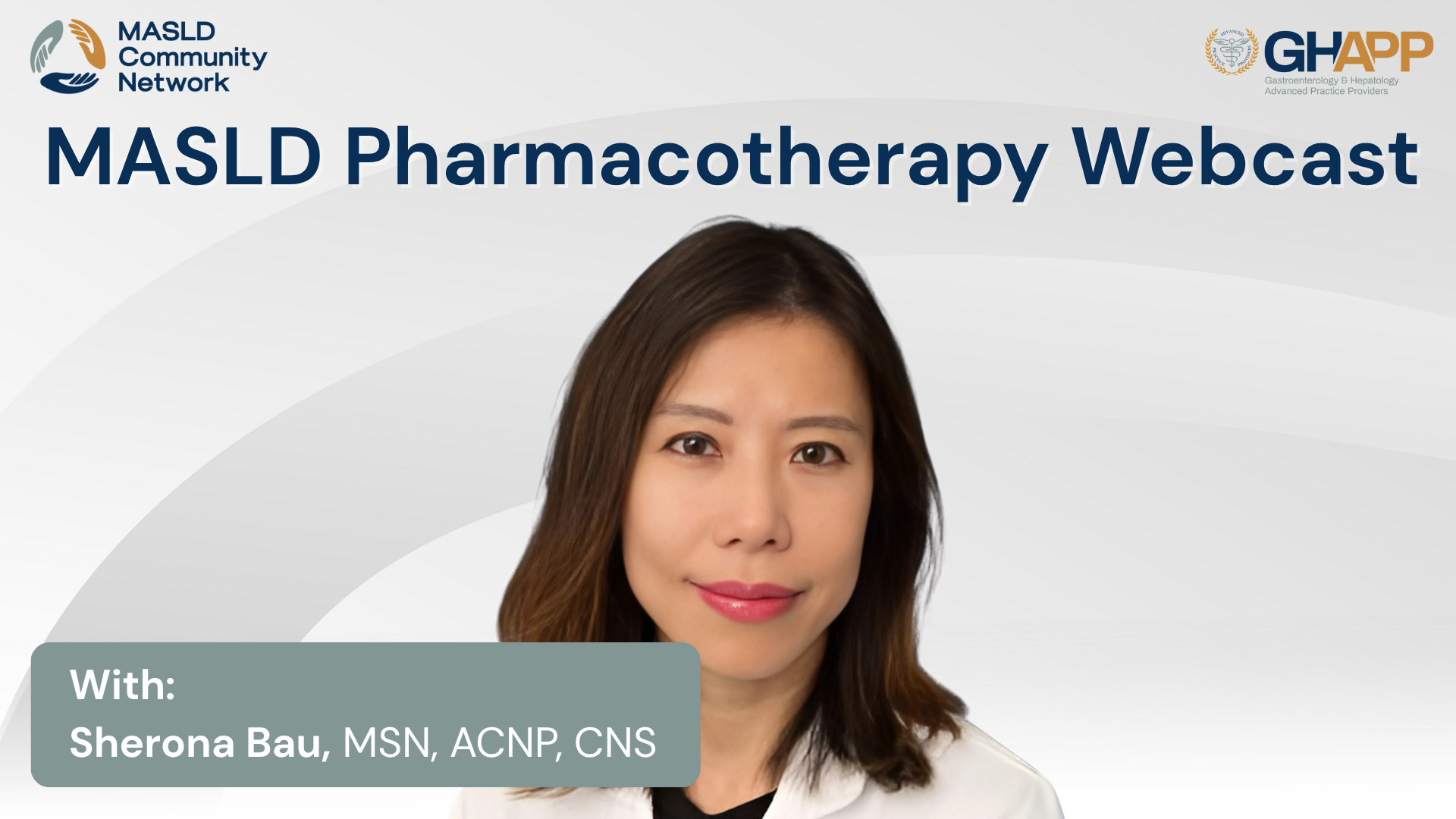
MASLD Pharmacotherapy

In this dynamic and highly informative session, Sherona Bau, NP, presents a comprehensive overview of pharmacotherapy in MASLD and MASH, breaking down current treatment strategies and emerging therapies for patients with metabolic dysfunction-associated steatotic liver disease. This presentation, part of the MASLD/MASH Community Network, begins by contextualizing the recent nomenclature shift from NAFLD/NASH to MASLD/MASH and its clinical implications. Sherona explores lifestyle intervention targets, including Mediterranean diet, weight loss goals based on fibrosis stage, and the role of GLP-1 and GIP receptor agonists in improving liver health. She highlights the ESSENCE trial results for semaglutide, discusses the only FDA-approved therapy to date—resmetirom (Rezdiffra)—and explains its mechanism of action via thyroid hormone receptor beta activation. The session dives deep into efficacy data from the MAESTRO-NASH trial, side effect profiles, drug–drug interactions, and monitoring recommendations. She also previews a pipeline of promising agents in phase 2 and 3 trials—including tirzepatide (GLP-1/GIP), cotadutide (GLP-1/GR), pemvidutide (GLP-1/GIP), and retatrutide (GLP-1/GIP/GR)—offering insight into what’s next in the evolving treatment landscape. This is a must-watch for hepatology and endocrinology clinicians focused on the future of fatty liver management.
Watch Now
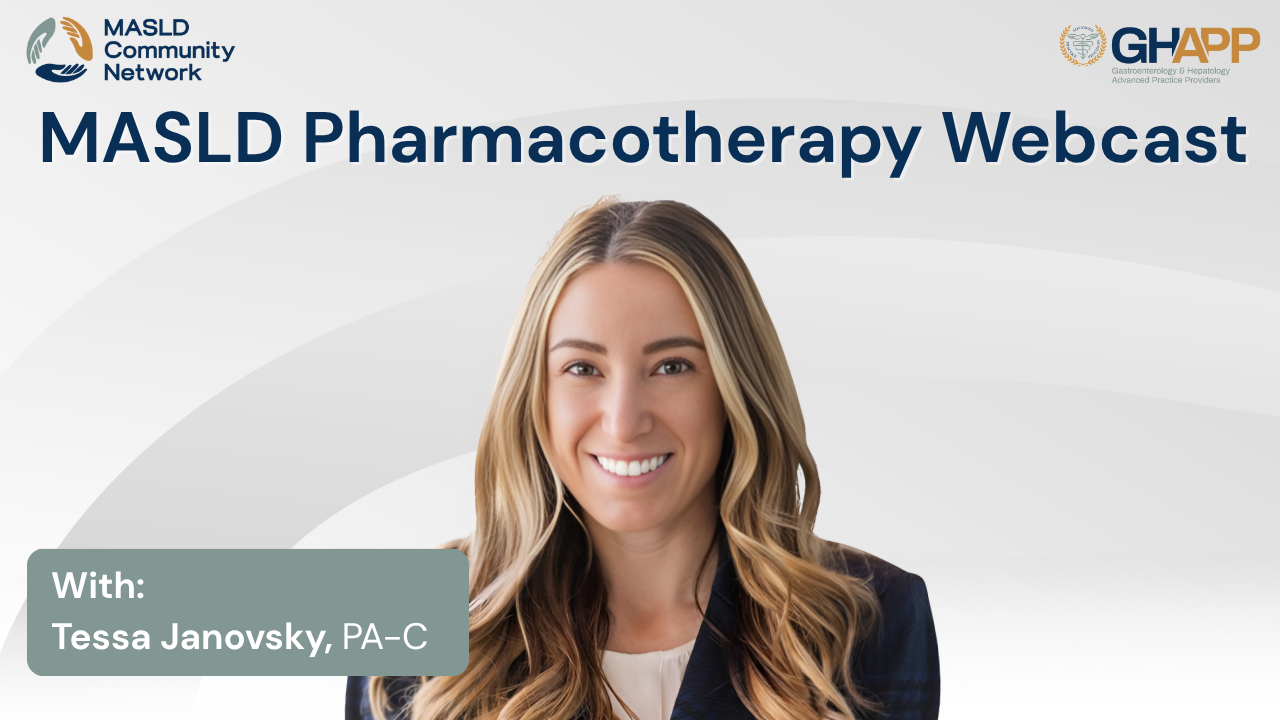
MASLD Pharmacotherapy With Tessa Janovsky

Join Tessa Janovsky, PA-C from Arizona Liver for a practical update on MASLD pharmacotherapy—from whole-patient metabolic management to liver-directed treatment. This session reviews why care must target the entire metabolic syndrome (weight, type 2 diabetes, hypertension, dyslipidemia, cardiovascular risk), the impact of 7–10% weight loss (and why many patients need adjuncts), and how to choose between diet/physical activity, anti-obesity medications, and bariatric surgery for select cases. You’ll learn where GLP-1 receptor agonists fit (mechanism, expected weight and glycemic effects, GI side effects, peri-procedure anesthesia considerations, and use in compensated disease), when to use statins safely in fatty liver, and how to stage and monitor with FIB-4, FibroScan/elastography, and other non-invasive tests. Tessa also summarizes legacy data for vitamin E and pioglitazone (benefits and limitations) and highlights the first FDA-approved therapy for non-cirrhotic MASH with F2–F3 fibrosis, resmetirom—including mechanism (THR-β agonism), tolerability, drug–drug interaction checkpoints, and practical follow-up (restaging and lifestyle coaching). If you’re a GI/hepatology clinician or APP aiming to streamline risk reduction, staging, and evidence-based therapy for MASLD/MASH, this concise talk delivers clinic-ready guidance.
Watch Now
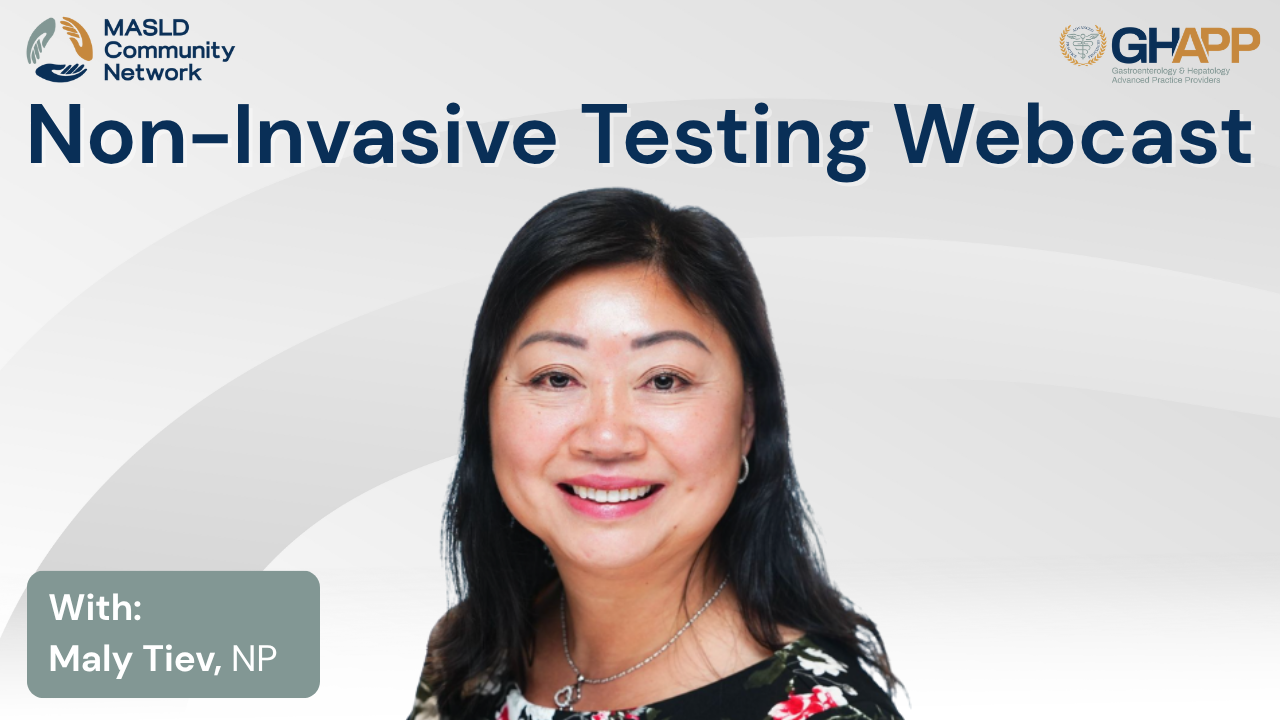
Non-Invasive Testing With Maly Tiev

Maly Tiev, NP, NYU Langone Health, shares a practical, case-based walkthrough of non-invasive testing (NITs) for MASLD/MASH—showing how to move from initial risk identification to confident staging and follow-up without a biopsy in most patients. Using Albert’s case, a 65-year-old with steatosis and mild ALT elevation, she explains how to apply FIB-4 first, then layer in FibroScan/VCTE with Liver Stiffness (kPa) and CAP for fat quantification, plus when to order ELF or MRI elastography. You’ll learn reliability checks for FibroScan, common confounders, insurance/operational tips for MRE, and an easy algorithm for primary care/endocrine clinics: start with FIB-4 → triage by cutoffs → use VCTE/ELF → refer when intermediate or high risk. She closes with clear next steps for low-risk patients—lifestyle modification, cardiometabolic optimization, and repeating NITs in 2–3 years—and when to escalate to hepatology for advanced disease.
Watch Now
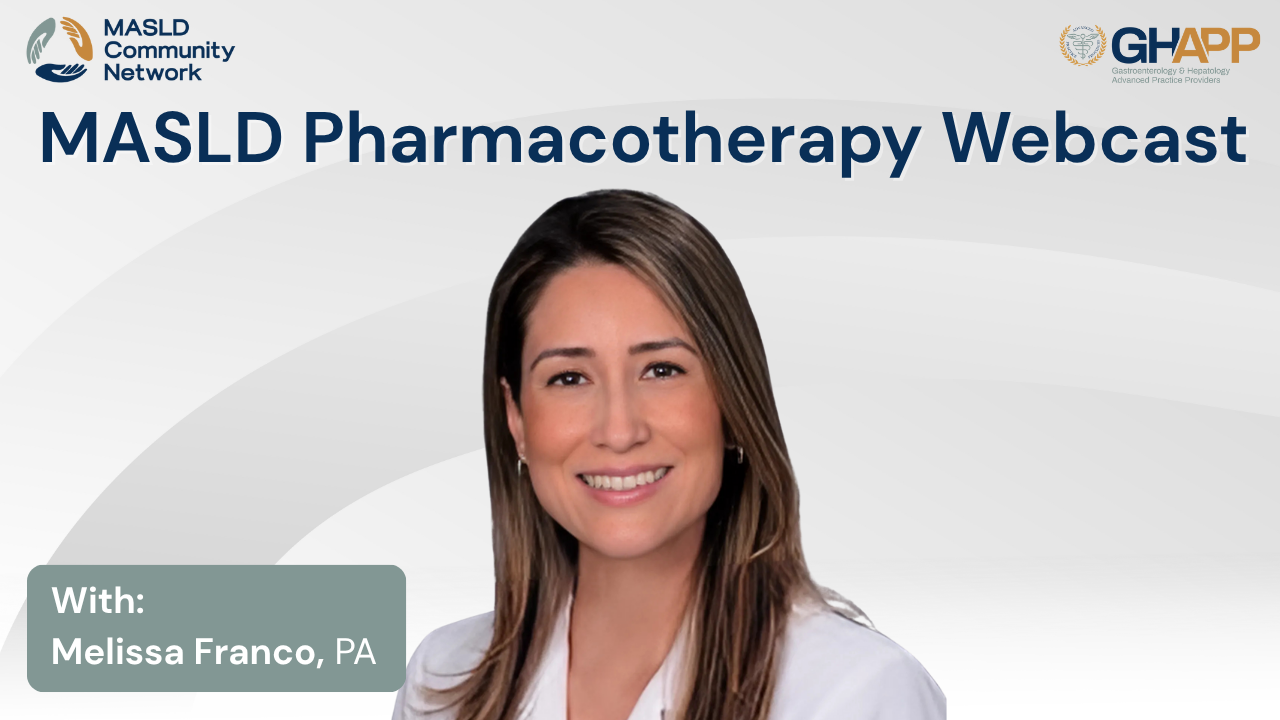
MASLD Pharmacotherapy With Melissa Franco

In this session from the MASLD Community Network, Melissa Franco, PA from the University of Miami, provides a comprehensive overview of pharmacotherapy for MASLD and MASH. She reviews the role of lifestyle interventions such as the Mediterranean diet, weight loss, and exercise while highlighting the importance of controlling metabolic and cardiovascular risk factors including diabetes, hypertension, and dyslipidemia. Melissa discusses pharmacologic options including GLP-1 receptor agonists like semaglutide, which have shown promise in improving both weight loss and liver histology, as well as the evolving roles of vitamin E, pioglitazone, and resmetirom (Rezdiffra)—the first FDA-approved therapy for non-cirrhotic MASH with stage 2–3 fibrosis. Practical considerations, safety profiles, drug-drug interactions, and monitoring strategies are explained, giving clinicians a clear framework for managing patients with fatty liver disease. This session emphasizes why a combination of lifestyle changes, risk factor control, and emerging pharmacologic therapies are critical for improving outcomes in MASLD and MASH.
Watch Now
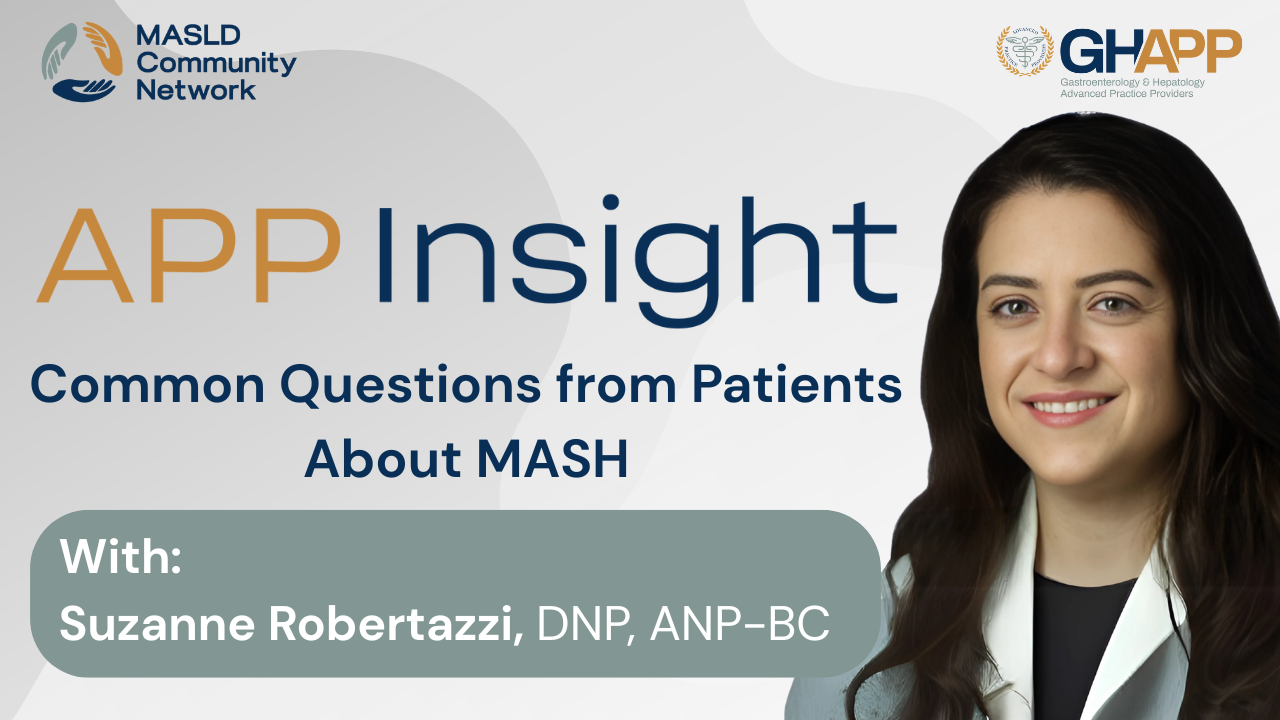
Common Questions from Patients About MASH

In this focused episode, Suzanne Robertazzi, NP at the Washington DC VA, shares expert insights on how to prevent recurrence of MASH (Metabolic-associated steatohepatitis) and MASLD (Metabolic dysfunction-associated steatotic liver disease) in liver transplant recipients. Drawing on her experience caring for post-transplant veterans, Suzanne explains that MASH can return even after liver transplantation, making ongoing metabolic management essential. She outlines key strategies including tight blood sugar and blood pressure control, especially since transplant medications can contribute to hypertension. Suzanne also emphasizes the importance of introducing regular physical activity post-recovery and adopting a Mediterranean-style diet—while tailoring nutrition guidance to meet the needs of patients in urban settings with limited access to fresh foods. This video is a must-watch for transplant teams, hepatology providers, and patients seeking to extend the life and health of their new liver through evidence-based lifestyle and clinical interventions.
Watch Now
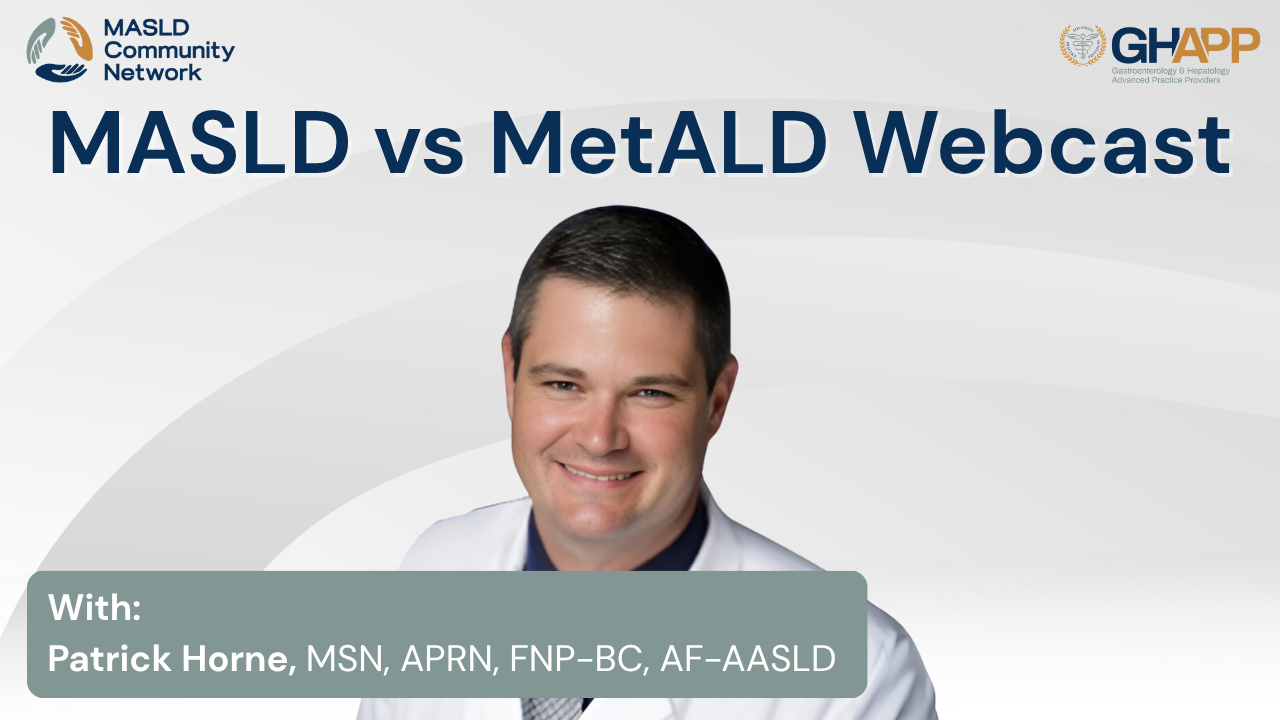
MASLD vs MetALD With Patrick Horne

In this case-based session from the GHAPP MASLD Community Network, Patrick Horne, NP explains how to differentiate metabolic dysfunction–associated steatotic liver disease (MASLD) from metabolic dysfunction plus alcohol-associated liver disease (MetALD). Through the story of a 52-year-old patient with F3 fibrosis and severe steatosis, he reviews the modern SLD framework, metabolic risk factors (e.g., BMI, PCOS, hypertension, hyperlipidemia), and how alcohol intake interacts with insulin resistance, the gut microbiome, and hepatic lipid handling to accelerate inflammation and fibrosis. Patrick demonstrates practical tools—clear “standard drink” counseling, thorough history, AUDIT-C screening, and objective biomarkers like PEth—to uncover under-reported alcohol use and classify patients on the MASLD–MetALD–ALD spectrum. Management takeaways include Mediterranean-style nutrition, exercise and weight-loss targets, consideration of pharmacologic options in advanced fibrosis, firm guidance on alcohol cessation, and nuanced discussion of HCC surveillance in F3 disease. Ideal for APPs and hepatology clinicians, this talk delivers actionable algorithms, definitions, and trial-readiness considerations to standardize MetALD assessment and improve outcomes in steatotic liver disease.
Watch Now

APP Insight: Common Questions from Community GI About MASH

In this episode, HoChong Gilles, DNP, FNP-BC, a seasoned hepatology expert and Clinical Program Director at the Central Virginia VA Health Care System, addresses a frequently asked question from primary care and community GI providers: How do you risk stratify patients without access to a FibroScan? Drawing on over 25 years of clinical experience, HoChong outlines practical strategies for assessing liver fibrosis using the FIB-4 score—a simple calculation based on patient age, ALT, AST, and platelet count. She also discusses how tools like the Enhanced Liver Fibrosis (ELF) test, available through Quest or Labcorp, can serve as valuable alternatives in the absence of elastography. Whether you're managing incidental hepatic steatosis or evaluating elevated liver enzymes, this episode offers step-by-step guidance for using non-invasive biomarkers to stratify liver disease risk and guide referrals effectively. Perfect for clinicians in primary care, GI, and hepatology seeking practical, accessible tools for early liver disease assessment.
Watch Now

APP Insight: Common Questions from Community GI About MASH

In this informative video, Janet Gripshover, DNP, FNP-BC, and nurse manager for the liver transplant program at Cedars-Sinai, answers key questions about managing MASH (Metabolic Dysfunction–Associated Steatohepatitis) and navigating non-invasive testing. She addresses a common clinical challenge—what to do when FIB-4 and FibroScan results are discordant. Janet explains that while non-invasive tests are useful, they're not foolproof, and when results are unclear—especially in patients with significant metabolic risk factors—liver biopsy remains the gold standard for accurate diagnosis. She also shares expert recommendations on dietary changes for patients with fatty liver disease, emphasizing alcohol avoidance, high-protein, low-fat, and lower-carb diets, as well as achievable weight loss goals (around 5% of body weight). Janet highlights when to escalate care beyond lifestyle interventions—typically after 3 to 6 months if there’s no improvement—and discusses options such as pharmacologic therapy or bariatric surgery. This video provides practical, evidence-based guidance for healthcare providers managing the complexities of MASLD and MASH.
Watch Now
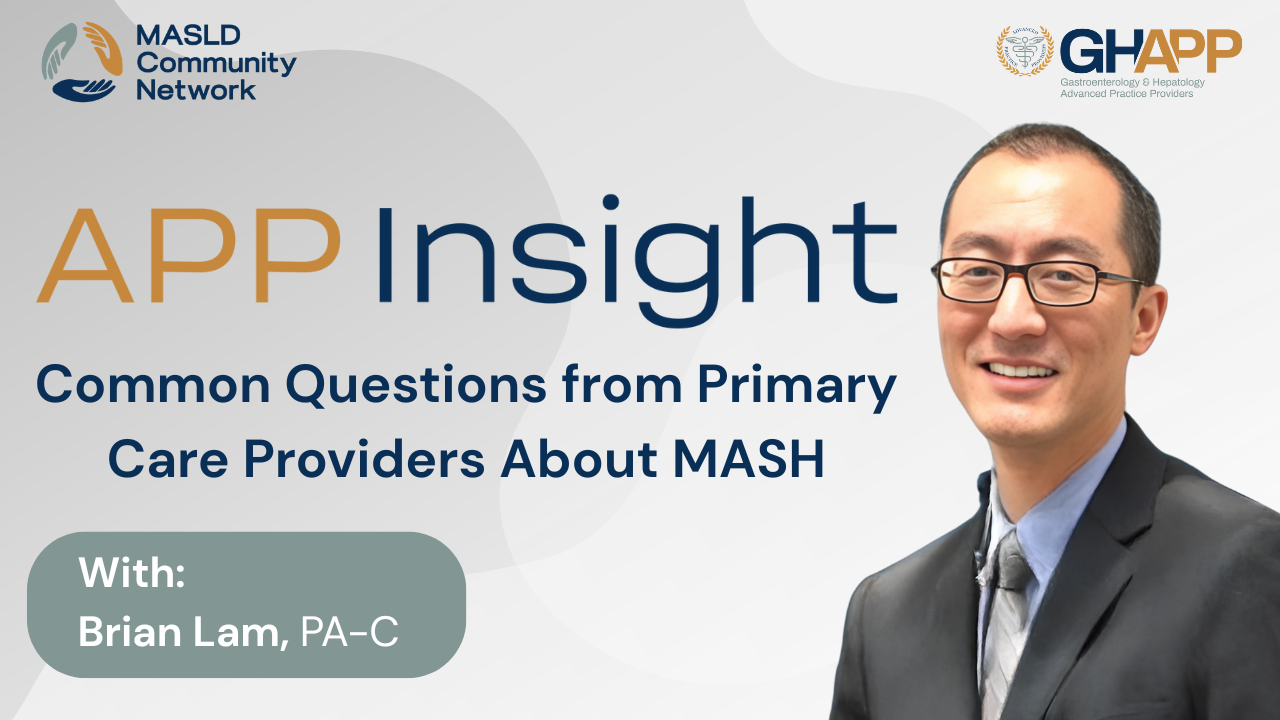
Common Questions from Primary Care Providers About MASH

In this FAQ session, Brian Lam, PA-C, breaks down a common question he receives from primary care providers, endocrinologists, and even other GI specialists: Which patients with fatty liver should be referred to hepatology or GI for further evaluation? Using a clear and practical approach, Brian explains how to apply FIB-4, a simple lab-based non-invasive test, to guide referrals. He emphasizes that patients with metabolic syndrome—especially those with diabetes—are at significantly higher risk for MASH (Metabolic dysfunction-associated steatohepatitis), with roughly 1 in 3 diabetic patients affected. If the FIB-4 is greater than 1.3, or greater than 2.0 in adults over 65, it's time to refer. Brian also highlights the utility of FIB-4 with reflex to ELF, now available through major labs like LabCorp and Quest, as an efficient two-step method to detect advanced fibrosis and at-risk MASH. This video is perfect for busy clinicians looking for a referral-friendly workflow to catch MASH early and improve liver health outcomes in high-risk populations.
Watch Now
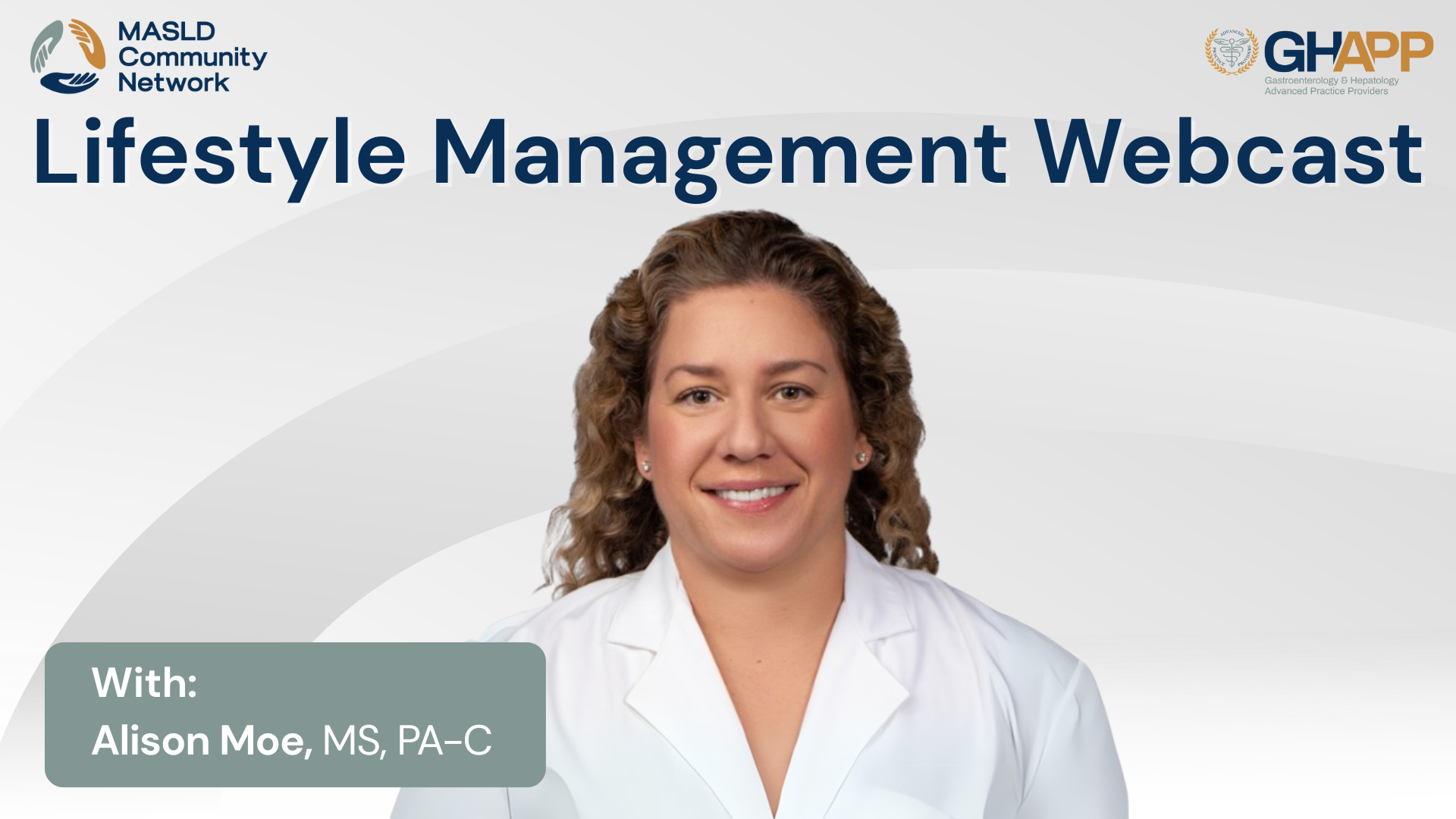
Lifestyle Management With Alison Moe

Join Alison Moe, PA-C, from Atlanta Gastroenterology Associates, as she walks through a real-world clinical case highlighting the challenges and strategies in managing Metabolic Dysfunction-Associated Steatotic Liver Disease (MASLD) and Metabolic Dysfunction-Associated Steatohepatitis (MASH). In this engaging and educational session, Alison shares the case of a 65-year-old Hispanic male with obesity, type 2 diabetes, and fatty liver disease—diving deep into non-invasive diagnostic tools, including FIB-4 scoring and FibroScan, and how these help guide risk stratification for liver fibrosis. The discussion emphasizes the crucial role of dietary counseling, culturally sensitive lifestyle modifications, and exercise guidance to slow or even reverse disease progression. Learn how to set achievable goals for patients and explore effective methods for improving glycemic control, BMI, and overall liver health. Alison also touches on evidence-based interventions such as the Mediterranean diet, resistance training, and intermittent fasting, supported by AASLD and European liver guidelines. Whether you're a clinician treating MASLD or simply interested in the evolving approach to fatty liver disease, this case study offers practical takeaways and guidance to optimize patient outcomes.
Watch Now





 September 2025
September 2025 